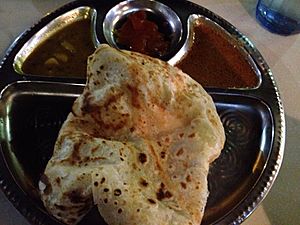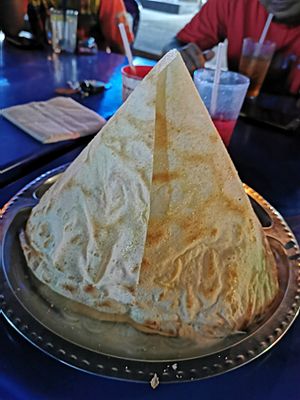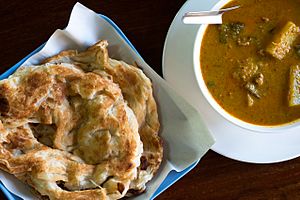Roti canai facts for kids
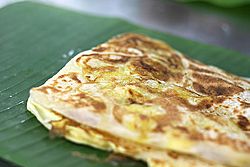
Roti telur, a type of roti canai with egg filling, served on a banana leaf.
|
|
| Alternative names |
|
|---|---|
| Type | Flatbread |
| Course | Main course |
| Region or state | Southeast Asia |
| Associated national cuisine | Brunei, Indonesia, Malaysia, Singapore and Thailand |
| Created by | South Indian diaspora in Southeast Asia |
| Serving temperature | Hot |
| Main ingredients | Flour |
| Variations | Roti tissue, murtabak |
Roti canai (say 'roh-tee cha-nai') or roti prata is a yummy flatbread from India. You can find it in many countries in Southeast Asia, like Brunei, Indonesia, Malaysia, Singapore, and Thailand. People usually eat it with dal (a lentil stew) or other kinds of curry. But it can also be sweet or savory, with fillings like meat, eggs, or cheese.
This tasty dish became popular around the 1800s. It's a favorite breakfast or snack, especially in Brunei, Indonesia, Malaysia, Singapore, and Thailand. Roti canai is a great example of how South Indian food spread to this part of the world. It's believed that Indian people brought the dish during the time of British Malaya, the Dutch East Indies, and the Straits Settlements. You can often find it at street food stalls called "Mamak" stalls in Brunei, Indonesia, Malaysia, and Thailand. In Singapore, it's sold in hawker centers.
Some people think roti cane was introduced even earlier, in the 1600s, in Aceh and North Sumatra. Indian traders might have brought it then. In Indonesia, you'll find roti cane a lot in Sumatra, where many people of Indian background live.
Contents
What's in a Name?
The word Roti means bread in Sanskrit and most other Indian languages. The word canai has a few possible meanings. Some say it comes from Chennai, a city in South India (which used to be called Madras). Others think it comes from channa, a dish from Northern India made with spicy chickpeas, often served with this bread.
However, the Oxford English Dictionary says canai comes from a Malay word. This Malay word means "to roll dough very thinly."
In Singapore, this dish is called roti prata. This name is similar to the Indian words paratha or parotta. The Hindi word paratha simply means "flat."
How Roti Canai is Made
Roti canai is made from dough. This dough usually has fat (like ghee), flour, and water. Some recipes also add sweetened condensed milk. The cook kneads the dough many times, then flattens it, oils it, and folds it. This process creates many thin layers.
Next, the dough ball is flattened and stretched until it's super thin, almost like paper. Cooks often do this by "tossing" it on a flat surface. Then, they gather the thin dough into a long, rope-like shape. This "rope" is then twisted into a knot or a spiral and flattened again. When it's cooked, it becomes flaky and delicious!
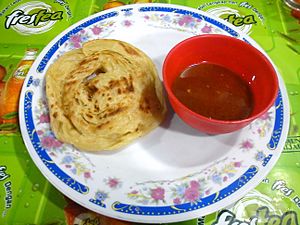
Before the 1970s, cooks would often make the dough into a spiral, like the "roti bomb" today. But now, they use less dough for each roti, so this isn't as common. When making roti with fillings, like eggs or onions, the fillings are spread on the thin dough. Then, the dough is folded around the fillings before cooking.
Different Kinds of Roti Canai
Plain roti is often called roti kosong, which means "empty bread" in Malay.
Traditionally, roti canai is served with dal (lentil) curry. But you can also eat it with other curries:
- Kari ayam: chicken curry
- Kari daging: beef curry
- Kari kambing: mutton (sheep meat) curry
- Kari ikan: fish curry (often with stingray)
- Kari campur: mixed curry
- Kari kacang kuda: a chickpea curry
Roti in Indonesia
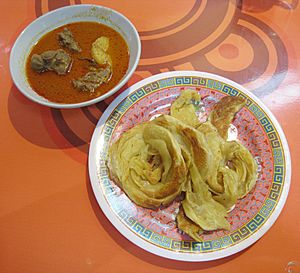
Roti cane arrived in Indonesia when Muslim Indian people moved to the Aceh Sultanate in Sumatra around the 1600s. Later, it spread to other parts of the Dutch East Indies in the early 1800s. Roti canai is very popular in Sumatra, especially in Aceh, North Sumatra, and West Sumatra.
It has become a part of Malay cuisine in Sumatra, Acehnese cuisine, and Minangkabau cuisine. So, you'll find Malay, Aceh, and Minangkabau restaurants serving roti canai with mutton curry, even if they are not run by Indian people.
In Ampel, an Arab area in Surabaya, it's called roti maryam. In Javanese areas, people call it roti konde because it looks like a hair bun (konde in Javanese). Even with different names, these types are all similar to the Indian paratha. Indian-style roti is usually served with kari kambing (mutton curry).
Roti in Brunei and Malaysia
Here are some different kinds of roti canai you can find in Brunei and Malaysia:
- Murtabak: A very thick roti filled with egg, meat, onions, and spices. In Brunei, Malaysia, and Singapore, it's cooked on a flat grill. In Indonesia, it's often deep-fried and quite oily. In Thailand, it's called "Mataba." Most murtabak in Malaysia have less meat and more egg than those in Singapore. There's also murtabak cheese with added mozzarella.
- Roti telur: Roti with an egg (telur) inside.
- Roti jantan: Roti telur with two eggs inside.
- Roti bawang: Roti with onion (bawang) inside.
- Roti telur bawang: Roti with both eggs and onions inside.
- Roti boom (or bom): A smaller, thicker roti with the dough wound in a spiral. It's often served sweet with sugar and margarine, or with curry.
- Roti planta: Filled with margarine (often Planta Margarine) and sugar.
- Roti sardin: Filled with canned sardines, sometimes with egg and mixed with ketchup or sambal. It's similar to murtabak.
- Roti pisang: Filled with sliced bananas.
- Roti sayur: Filled with shredded or sliced vegetables.
- Roti salad: Raw shredded vegetables rolled up inside a piece of roti.
- Roti tissue / roti tisu: A very thin and flaky roti, usually with sugar and condensed milk sprinkled on top. It's also called roomali roti, which means "handkerchief roti" in Hindi.
- Roti kaya: With kaya (coconut jam) spread.
- Roti maggi: Filled with cooked instant noodles, usually Maggi brand.
- Roti cheese: Filled with cheese.
- Roti milo: Filled with Milo powder.
- Roti cobra: Roti served with chicken curry and a fried egg on top.
- Roti banjir: ("flooded roti") Roti, often chopped into pieces, with a lot of curry poured over it.
- Roti tsunami: ("tsunami roti") Roti banjir with added sambal (chili paste) and soft-boiled eggs.
- Roti Doll: ("Doll's roti") Roti banjir with added sambal and a fried egg on top. This is common in northern Malaysia, especially in Alor Setar. It's named after a customer.
- Roti Sarang Burung: ("bird's nest roti") Roti cooked in a doughnut shape with a fried egg in the middle hole. It's similar to egg in the basket.
You can also buy roti canai as frozen food or from wrap food shops.
Roti in Singapore
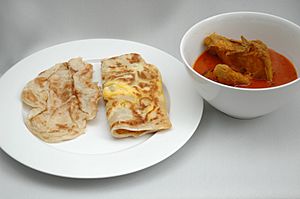
Roti prata in Singapore is a fried flatbread cooked on a flat grilling pan. It's usually served with sugar or a vegetable or meat curry. It's also often cooked with cheese, onions, bananas, red beans, chocolate, mushrooms, or eggs.
To make roti prata, the cook flips the dough to make it a large, thin layer. Then, they fold the edges inwards. The dough is cooked on a large, round iron pan. The cooking takes about two to five minutes.
- Roti tampal or Roti plaster: (in Singapore) Roti with an egg "plastered" on one side. The yolk can be runny or fully cooked.
Roti in Thailand
In Thailand, roti (sometimes spelled ro tee) is often sold from street carts. These are usually halal and sold by Thai Muslims. Roti thitchu (Thai for "tissue") is a Thai roti canai that is fluffed up after frying. It's served with a Thai-Muslim style beef curry.
Unlike in Malaysia, Singapore, or Indonesia, Thai roti often has sweet fillings instead of spicy or savory ones. Popular sweet kinds include mango, banana, sugar, condensed milk, jam, peanut butter, and Nutella roti. You can also find egg roti, often with sweetened condensed milk on top.
Gallery
-
Roti canai is cooked on a tava with a lot of oil.
See also
 In Spanish: Roti canai para niños
In Spanish: Roti canai para niños


